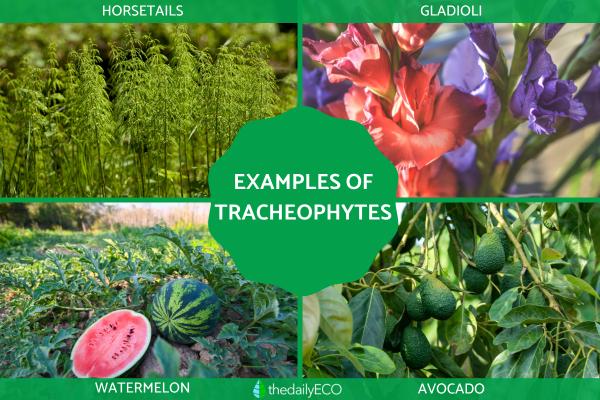
Non-vascular plants are the oldest plant species on planet Earth. It wasn't until 400 million years ago that vascular plants first developed their definitive vascular structures. Also known as tracheophytes, vascular plants have now become the dominant type of plant on our planet with around 350,000 individual species. They are also the most diverse in terms of appearance and have adapted to almost all ecosystems. The slow process of evolution has endowed them with certain representative characteristics which allow for the development of plan t structures such as leaves and flowers.
To learn more about the botanical importance of these plants, thedailyECO asks what are tracheophytes plants? We provide characteristics of tracheophyte plants, explain how they are classified and show examples of tracheophytes in nature.
What are tracheophytes plants?
Tracheophytes are vascular plants, plants which were once known as cormophyte plants (i.e. plants with roots, stems and leaves). Vascular plants have vascular tissues, specialized tissues which form structures for the conduction of minerals, water and other nutrients. These are necessary for the plant's development and survival.
As they are considered vascular plants, tracheophytes exist in contrast to non-vascular plants. This latter category includes plants with simpler structures such as mosses and hornworts. These plants are poikilohydric because they cannot transport water efficiently, so need to constantly take it from their environment. Vascular plants can take moisture and nutrients from various substrates and even other plants. They can then transport them using specialized tissues such as the xylem and phloem.
Discover more about the differences between vascular and non-vascular plants with our related guide.

Classification of tracheophytes
The evolution of tracheophytes has generated several taxonomic classifications. In fact, there is much debate among botanists over the taxonomy of plants. Sometimes it is difficult for experts to come to a consensus. This is partly because the number of tracheophyte plants is more than 350,000 individual species. For this reason, it has been helpful to simplify their classification using the following divisions:
- Psilopsida: the most primitive tracheophyte plants. There only three known and extant that species exist within this category.
- Lycopsida: this group consists of more than 1,000 species. They are very ancient and originate almost entirely from the Lycopodiopsida class, commonly known as club mosses. Are related guide provides more by asking what are club mosses?
- Sphenopsida: commonly known as horsetails, these are plants with a strong rhizome that grew thousands of years ago and can reach a maximum height of two meters. They have been used in traditional medicine for many years.
- Pteropsida: this is the largest group of tracheophytes and the largest group in the entire plant kingdom. It is divided into three main branches.
Traquophyte plants in the dividison Pteropsida
- Filigree plants: plants have leaves that are more developed than the stem and lack nodes or inter-nodes. This group includes more than ten thousand species, primarily containing several species of ferns and other leafy plants typical of tropical climates. We explain how ferns reproduce in our related article.
- Gymnosperms: commonly known as conifers, these are plants that have flowers but no fruit. This false fruit is a method developed through evolution to protect the seed until it can produce a new plant. For this reason, gymnosperms are also known as non-flowering plants. They include trees and shrubs such as juniper, cypress, and pine.
- Angiosperms: also known as flowering plants, angiosperms are characterized by clearly differentiated tissues and organs. Within this group, we find herbaceous, shrubby and woody plants. Another characteristic is how the tracheophyte plants that are part of this group reproduce. Reproduction of the tracheophytes in this group occurs thanks to the flower, which has both male and female parts. Fertilization of the ovule is achieved and it is this which will produce the new plant. These are further divided into dicotyledons (have two cotyledons that grow on either side of the embryo) and monocotyledons (have a single embryonic leaf).
While vascular and non-vascular are two of the main categories of plant, so too are flowering and non-flowering plants. We explain more with our comparison of the differences between gymnosperms and angiosperms.
Characteristics of tracheophytes
We have provided a basic definition, but we can learn more about what are tracheophytes by providing the characteristics of vascular plants:
- Vascular tissue: the main characteristic of tracheophyte plants is their vascular tissue. Thanks to the structures this tissue creates, the plant is able to transport water and minerals through the xylem and phloem to obtain and produce its own food. This is essential for its development and growth. We explain more by asking what is the phloem and its function?
- Complex plant structure: while their complexity varies according to species, they are characterized by a more complex structure than those belonging to non-vascular plant groups. In fact, their morphology is much more uniform, always presenting a visible and orderly root system, stem and leaves.
- Growth: thanks to their structure and morphology, these plants achieve greater height and a better appearance than other plants. They range from the simplest herbaceous plants to vastly tall trees.
- Leaves: plants belonging to the tracheophyte group also have different types of leaves. Microphylls, macrophylls and megaphylls range in degree of evolution from least to most advanced.
- Habitats: tracheophytes have managed to adapt to the planet's diverse geographic zones, from aquatic to terrestrial habitats. However, they are most common in terrestrial ecosystems.

Examples of tracheophyte plants
As we have explained there are hundreds of thousands of tracheophyte plant, with more yet to be discovered. For this reason, we cannot list them all here. We can provide some examples of vascular plants to give an idea of the wide variety of tracheophytes plants:
- Common horsetail (Equisetum arvense)
- Common asparagus fern (Asparagus setaceus)
- European fan palm (Chamaerops humilis)
- Canary Island date palm (Phoenix canariensis)
- Floss silk tree (Ceiba speciosa)
- Carob (Ceratonia siliqua)
- European ash (Fraxinus excelsior)
- Stone pine (Pinus pinea)
- Mediterranean cypress (Cupressus sempervirens)
- Sago palm (Cycas revoluta)
- Ginkgo (Ginkgo biloba)
- Fig (Ficus carica)
- Gladioli (Gladiolus sp.)
- Red tulip (Tulipa agenensis)
- Avocado (Persea americana)
- Tobacco (Nicotiana tabacum)
- Poison ivy (Toxicodendron radicans)
- Banana (Musa spp.)
- Watermelon (Citrullus lanatus)
You can learn more about what makes vascular plants so much more complicated than non-vascular plants with our article on the different types of plant tissues.
If you want to read similar articles to What Are Tracheophytes Plants?, we recommend you visit our Biology category.